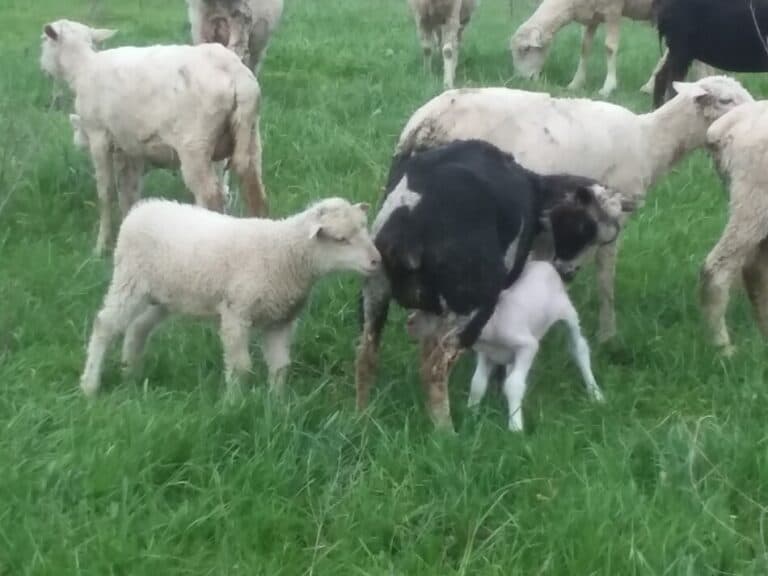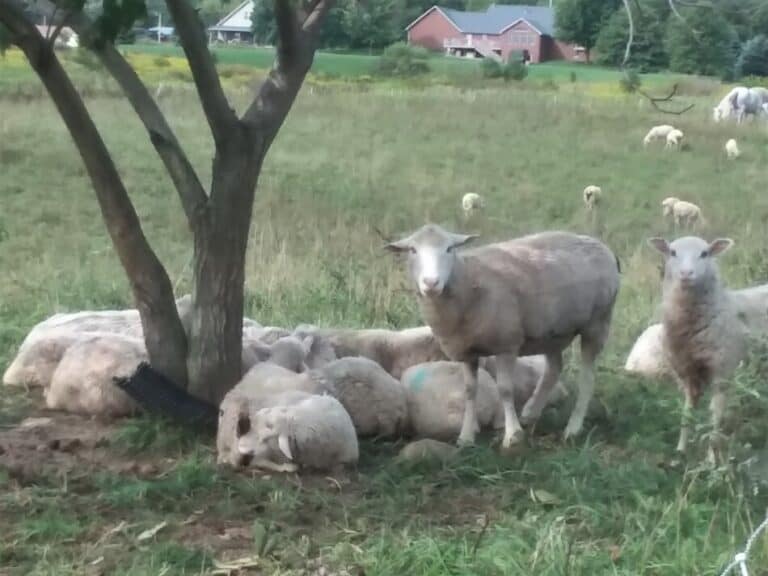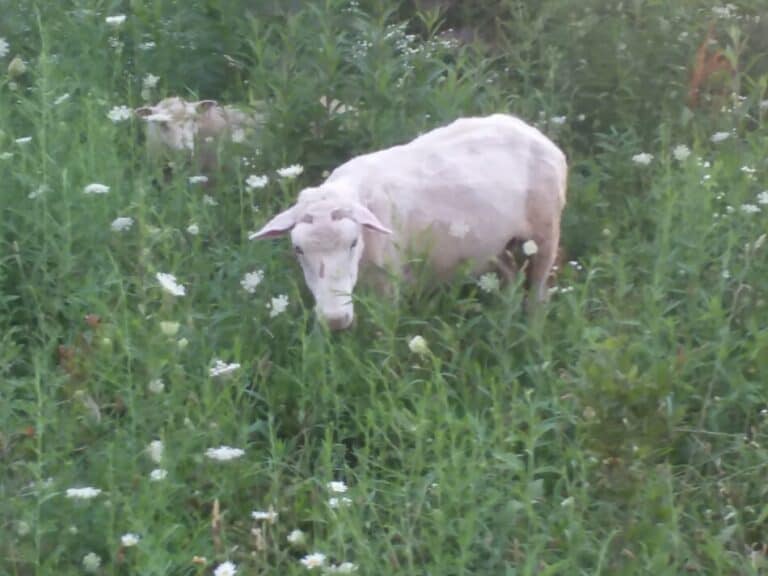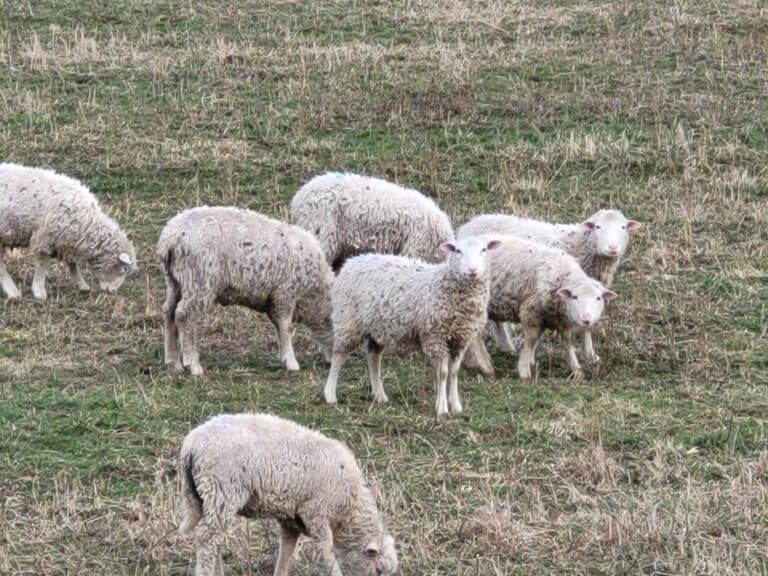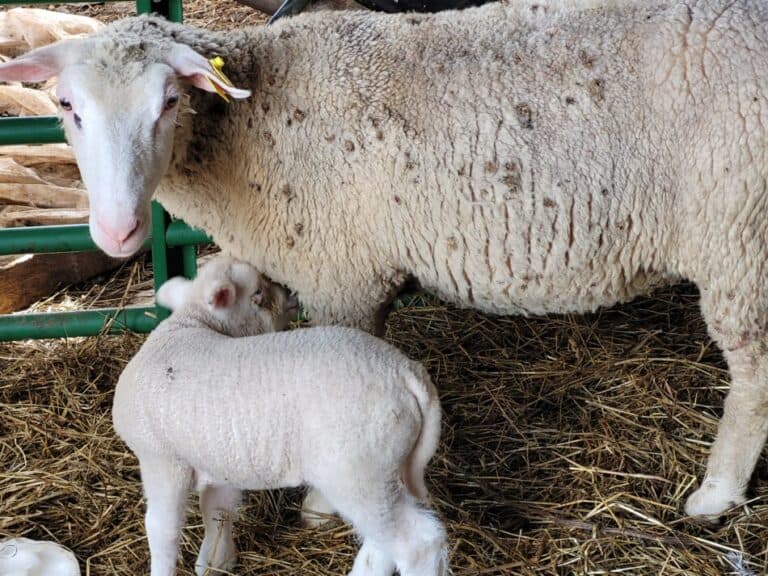Lambing Season: What To Expect And How To Be Ready
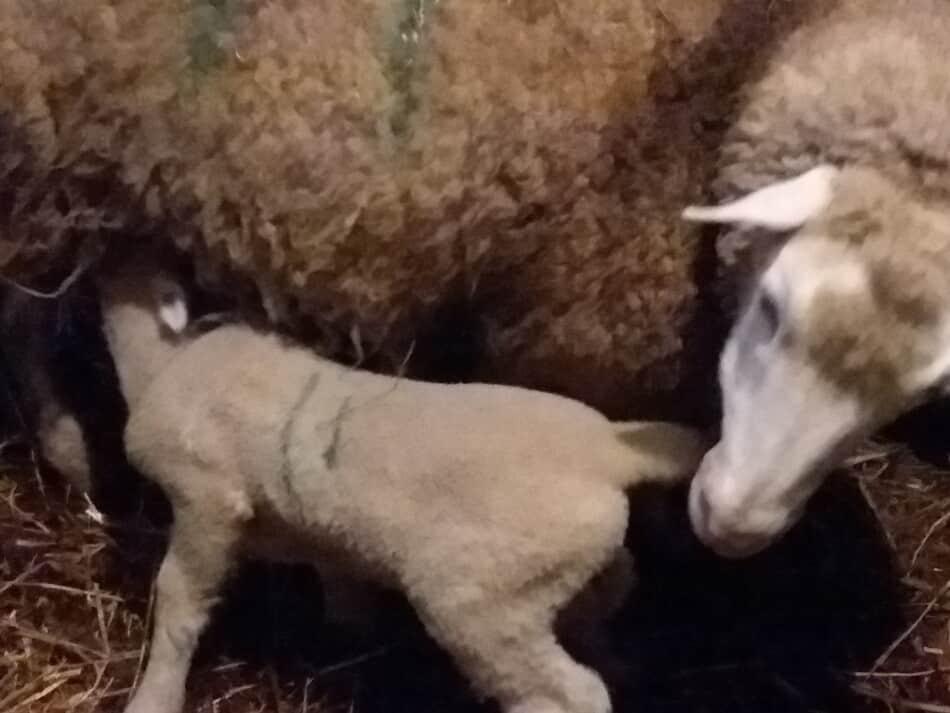
The start of lambing season is always a big day! Exciting but a bit scary, too! All of your preparation up until now will get you great results, or maybe not so great.
Since your sheep income for the whole year starts here, let’s make sure we are ready!
To be ready for lambing season, plan ahead. Have all lambing supplies on hand before the start of lambing, have lambing jugs ready to use if needed, have the sheep in an area that is easy to access and plan to spend extra time checking the sheep during lambing.
Lambing season is always a favorite time of the sheep farmer’s year. All of the preparation and planning for your flock will start to show up now.
Unfortunately, now is also when your lack of planning and preparation starts to show.
Many lambs and ewes will get along just fine without any help from the farmer, however, some will not. These are the ewes and lambs that can be saved but, without help, would not have lived.
Turning these potential problem animals into marketable lambs and ewes is an area where the savvy farmer can make the most of the flock. Preventable losses are a disaster for the bottom line.
To dive deeper into the profits (or lack of) in raising sheep consider reading my article Raising Sheep For Profit: Let’s Look At Some Numbers.
The main points on how to be ready for lambing season and what to expect are:
- Ewes should be in good shape (not fat or thin)
- Have lambing jugs (individual pens for the ewe and her new lambs) ready to be assembled
- Have a bucket for water for each jug
- Have an identification plan ready (marking paint, tags, or tattoos)
- Pasture lambing will be a bit different (no jugs)
Before lambing season check ewes
Ewe condition is important, not fat, not thin
Ideally, the ewes should be well fed but not fat coming into lambing. Proper body condition is important for ewe health and ease of lambing.
A thin ewe will have a harder time handling the stress of lambing and have less of a reserve of fat to draw from to feed the lambs. She is more likely to get sick and have a harder time recovering if she has any problems.
On the other hand, a fat ewe is a definite problem. Fat ewes will have more problems with difficult births and metabolic problems converting their energy into milk for the lambs.
Lambing jugs should be easily accessable

Lambing jugs are the small pen (6 ft. x 6 ft.) you put the ewe and her lambs in the first day or two after they are born.
Being in the lambing jug gives the lambs time to learn to recognize their mom and helps you to make sure the new babies are being looked after.
We use wooden gates that are six feet long to make the jugs. Ours are high enough so that we can barely step over the side.
The bottom boards of the gate are placed so that the lambs can not fit through the spaces between the boards.
We also keep a few wooden pallets and extra cattle panels available for when we need more jugs.
You can use whatever you have on hand of course, but the easiest to use jugs are made with the gates.
You will also need a bucket for water for each pen.
Mismothering lambs is a big problem
Most ewes want to have a lamb to take care of. Lambs can be confused as to who is their mom.
It is common for a ewe that has not given birth yet but will soon to start baaing and looking around for lambs.
Obviously, she won’t find them since they are not yet born but she will find other lambs and try to take care of them. This is called mismothering.
Mismothering is a problem because once the ewe has her own lambs she will be able to tell that the first lamb is not hers and she will not take care of it anymore leaving the lamb without a mom.
Putting the ewe and lambs in a lambing jug keeps them together until they bond so no lambs end up motherless due to confusion.
Have a can of spray on marking paint
An effective tool we use is spray on marker paint to number the ewes and lambs. Marker paint is simple to use and affordable.
It makes a huge difference for us to tell for sure which lambs are with their moms.
If you just have a small number of ewes you might not need the spray.
But lambs look quite a bit alike once they get to moving around and are always harder to tell apart than I thought they would be.
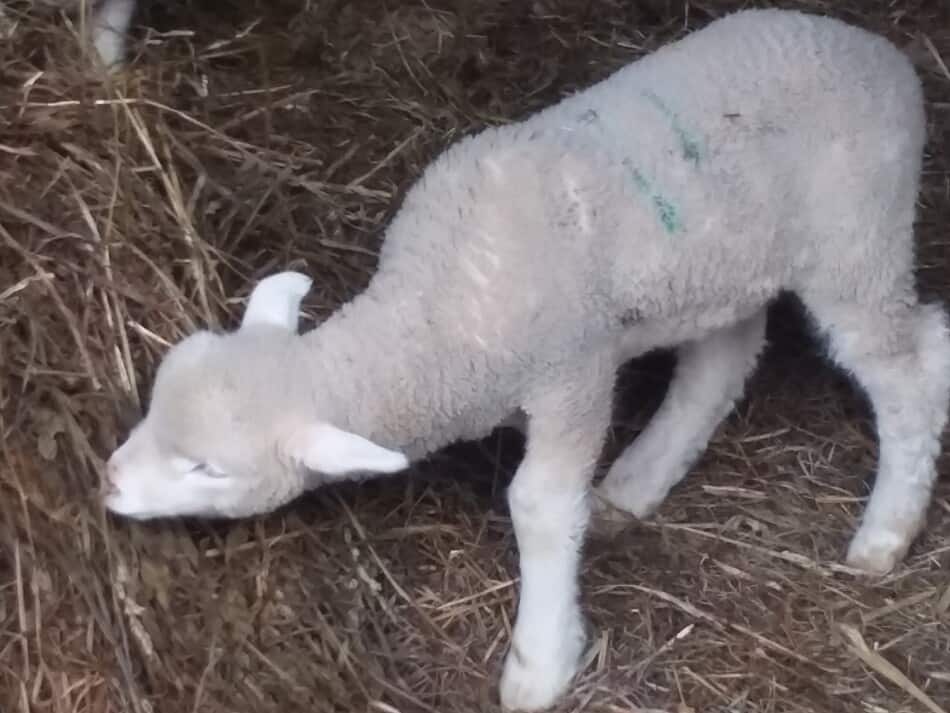
Marking paint is also a help for some one who is less familiar with the sheep doing a check for you.
In the past we always cheaped out here and that was a mistake since the spray is $10 and makes identification so much easier and super quick.
Be ready early, sheep don’t read the calendar
It is also worth noting to look at the calendar and plan on lambs showing up at least a few days before the actual five months are up.
For example, we just finished lambing in an early group of 35 ewes. The breeding window was eight days but the lambing window was 20 days.
Lambs started coming a week before they were due and extending a few days afterward.
When Do Sheep Breed? is an article I wrote that goes over the likely dates of the first lambs born, depending upon when you put in the rams.
The first lambs born will be early
Normally, the first few lambs will be born a bit earlier than your expected start of the lambing season when looking at the date on the calendar.
One or two ewes will lamb then all of a sudden everybody joins in and starts lambing.
Physical signs will show ewes soon to lamb
You can’t for sure but you can give a good guess. Here are some things to look for in a soon to be giving birth ewe:
- A full udder
- She does not eat when the rest of the ewes are eating
- She is the only one standing (or the only one laying down)
- She repeatedly gets up and down
- All of the other ewes are chewing their cud but she is not
- Calling for a baby that is not born yet
- Calling to lambs that are not hers
The lamb will be “diving” out of the birth canal
Once she is for sure in labor, you will see the water sac hang out.
Next comes the front feet, followed buy the nose, which will be laying on the legs at the knees. The lamb will “dive” out of the birth canal to be born.
As soon as the lamb is on the ground the umbilical cord will break which makes the lamb start to breathe. The ewe will stand and start licking it off.
The licking removes any of the placenta that is covering the nose and stimulates the circulation of the lamb to get it warmed up and working on standing to nurse.
Generally, if you listen you can hear the lamb nurse and if you watch you will see the tail wag when it finally gets things figured out.
Give the ewe time to birth the lambs herself.
If she has been struggling for a while with no visible progress then you need to look into the situation and determine how to help.
Assisting The Ewe At Lambing is an Ontario Ministry Of Agriculture article that has more of the specific details of lambing if you are interested.
Non “diving” lamb birth positions
For birth to go well the lamb must be in the dive position, any other presentation of lamb body parts equals problems.
Lambs can be head only, just one leg, both front legs but elbows tucked back, feet but no head, breech (backwards) two legs but from different lambs, and any other combination you could think of.
If you have two feet (from the same lamb) and the head in line to come out then pull, if not, push it all back in and try to rearrange the lamb.
This is tough but must be done. Once you notice problems, get some experienced help or just call the vet.
Checking ewes and lambs prevents losses
We check our ewes multiple times through the night, especially if it is going to be cold or windy.
You have to decide for yourself how often you want to check your sheep and how much or little assistance you are willing to provide.
Not doing anything to help ever will probably result in some lamb deaths, but this is nature’s way of handling problems.
We prefer to do what we can and just sell any lambs from ewes that needed help or were poor moms.
Only keep what you want to continue doing
As far as potential replacement ewes, anything you do to assist a lamb is likely to be something you will have to do for her lambs should you decide to keep her as breeding stock.
Sometimes you are not in the position to cull (sell poorly performing adults) as heavily as you would like to, for instance if you are building up your flock numbers.
Just be aware that whatever you accept and keep as breeding stock you will continue to get (and have to deal with every year).
Keep ewes with lambs as a group
Pretty quickly you will have a lot of lambs and ewes in jugs. Keep them in the jug for a day or two until it looks like they are well bonded.
Mark them before you turn them out into a group of ewes and new lambs, not with the other pregnant ewes.
We normally keep multiple births together for a bit longer to make sure all the lambs are ready for the bigger area and additional freedom.
More freedom equals more opportunity for a curious lamb to get into trouble, and usually lambs are far better at getting into trouble than getting out of it.
Keep lambs of the same age together
Try to keep the lambs around the same age together.
Once a lamb gets a bit of experience with zooming around and starts to explore the pen area he will inevitably figure out that other ewes have udders as well, not just his mom.
Now he will try to steal milk. This opportunistic milk stealing is normal.
Most ewes will shake off lambs nursing that are not their own, but not always.
For younger lambs, especially newborns the ewe has to hold still so she’s an easy target for a persistent older more capable lamb.
Older lambs will beat out younger ones for the milk, so keep them separate to even out competition.
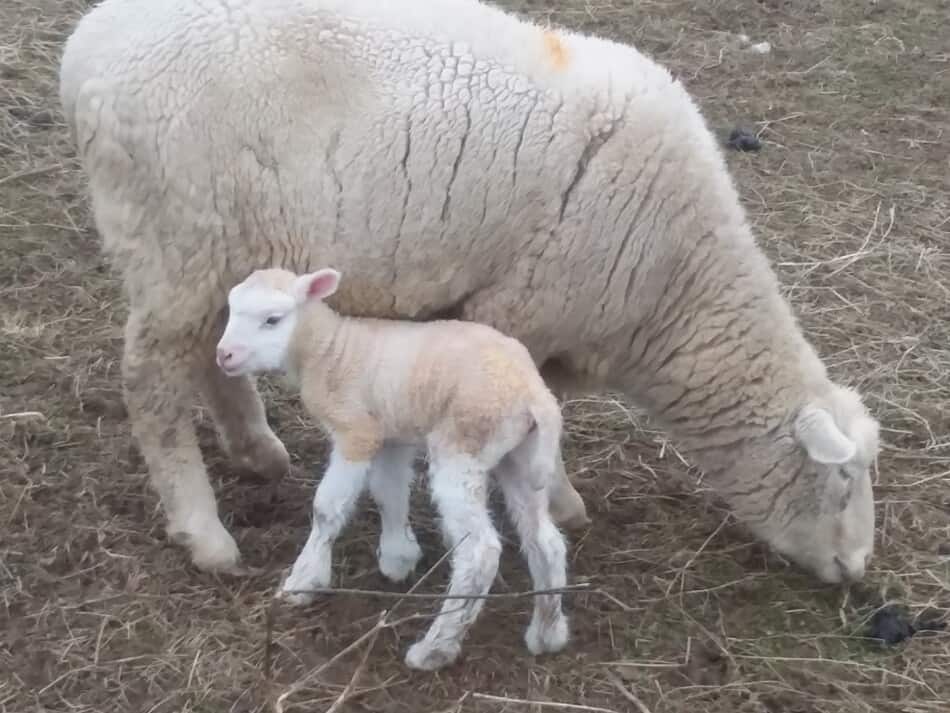
Divide the group and move the dividers as needed
We tend to divide the pen using the gates and feeders and move the division line down the pen as more lambs are born.
At first the ewes with lambs section is small, then as more lambs and ewes come out of the jugs (located on the sides of the main pen) we move the dividing line further into the no babies yet section.
A few lambs will be late born
Just like there were some early starters there will also be some late starters.
By now you should have a system that is working for you as far as when to turn out the ewes and lambs.
The last few lambs need attention too
A word of caution, stay vigilant as far as keeping watch over the lambs.
These last few babies are younger, possibly much younger, than the first few.
Newborn late lambs will need some time to get the coordination to be feisty enough to be as fast as the older lambs.
Lambing on pasture is doable
If you are planning on lambing out your ewes on pasture things will be a bit different for you than those planning on barn lambing.
Identification and mismothering are big issues here.
Identification on pasture is more challenging
Use the paint spray to match up lambs and ewes. Once marked, it is easy to tell from a distance who belongs with who.
The paint spray mark will last for a few weeks.
You will still have to catch them again before the mark fades out to put in tags or tattoos.
Be aware that young lambs can get hurt as the ewes try to run from you in the catch pen. Keep this in mind and be gentle.
Tag (or tattoo) the lambs ASAP
If you want tattoos or tags, do them now since lambs get faster than you very quickly. They will be very hard to catch once they are a few days old.
We normally do not tag our sheep. That may change in the future, but for now we manage the flock as a group.
This means that if we wanted individual records we have no accurate way to keep those records since we would be guessing.
If you decide to use tags for your pasture born lambs, they need tagged right away, otherwise they will be too quick and agile to catch.
Thinking that you will remember or be able to tell? To be blunt, not likely. If you want individual identification, get the tags.
Tags Vs Tattoos For Animal Identification is an article I wrote to help you decide between using tags or tattoos on your sheep.
Mismothering of pasture lambs can happen
That (identification) is the easy one, mismothering is more complicated.
We just go out and walk through the flock a few times a day making sure everyone is where they are supposed to be and then we check on ewes that are lambing.
If a ewe lambing starts to look like a group activity (other ewes are interested when she needs to be by herself) then we work on separating them.
This is not an exact science. We just keep working at it until they decide to go with their own babies or we take a jug out there.
Mismothered lambs get left behind
Again, the danger here is a lamb or multiple lambs being with the wrong mom and then not being taken care of when she has her own babies.
Or just a mom with twins or triplets that has a hard time keeping track of more than one baby.
The ones that wander off will miss a feeding (at best) or the worse outcome is that the left behind lamb will get weak and die.
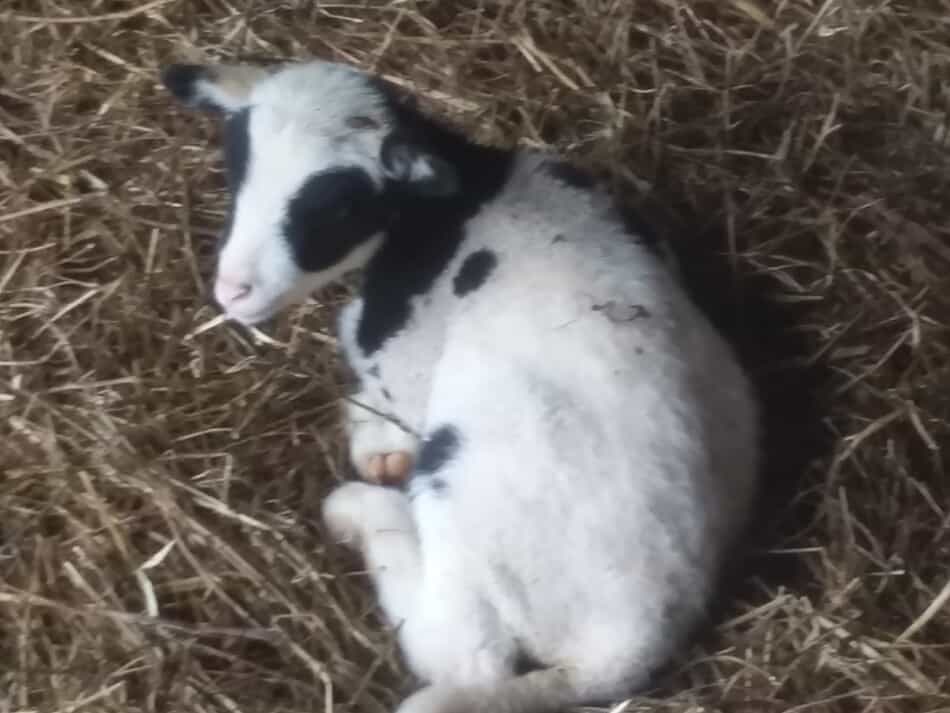
Lambs need some management
Once the lambs are all up and going, we take off tails. Admittedly this is not my favorite job but it has to be done.
If you live in a dry area then you might not need to bother, but here sheep with tails get manure all over their backsides and then they get fly strike.
Fly strike is maggots on the skin, which is very stressful for the sheep. Not to mention, really gross to see. Short tails seems to reduce fly strike.
Removing the lamb’s tail by cutting it
We use a knife and cut off the tail. Pick a cool, clear day so they will heal quickly.
The other method for taking off tails is to use elastrator bands.
Elastrator bands look like really small green rubber inner tubes that you stretch over the tail using a pair of special expanding pliers.
These bands are also commonly used for castration.
Elastrator bands can be put on the tail
The elastrator bands cut off the circulation to the area they are surrounding so that part of the body will dry up and fall off.
This sounds less stressful than cutting but actually it is more prolonged pain for the lamb.
Once you put on the band, the lamb will shortly be rolling around on the ground because of the lack of circulation causing pain.
Creep feeding lambs will help them grow
Consider putting in a creep feeder. This is an area that has special feed just for the lambs.
Sheep Creep Feeder is an article I wrote to show you the options you have if you decide to try it.
Creep feed is just an option, forage only lambs will grow just fine (as long as you keep the parasites under control).
However, lambs with access to a creep feeder will grow faster than lambs with out access to a creep feeder.
The ewes are kept out by making a gate or doorway with openings just big enough for the lambs but too small for the ewes to get in an hog all the feed.
There are manufactured creep panels and creep feeders available to use out on pasture as well. These creep feeders are self contained, meaning they are a box with a lamb only fence across the front.
You can make your own lamb creep area
I saw some fellow sheep farmers hang a gate a foot or so off the ground in a corner and the lambs just wiggle under it to get the creep feed. These guys had beautiful Suffolks and this system seemed to work well.
Our sheep are more scrappy than that and would have snuck right under that gate to the feed (where they would make themselves sick). Unfortunate for us, since that high gate as a separator was an easy, useful idea.
Creep panel are a gate the lambs fit through
We always use a creep panel, which is a gate with lamb size openings.
With a creep panel, the ewes are too big to go through the panel openings to get to the sectioned off area that has feed.
We also try to have some high quality hay in the creep pen for the lambs to start nibbling on.
Creep panels would just give the lambs access to another pasture or pen area.
Related Questions
What time of the year do sheep give birth?
Some breeds of sheep can have lambs anytime of the year, common examples of sheep that can breed and lamb year round are Dorset and Polypay sheep.
Most sheep breeds will lamb in the spring (but not other times of the year) at the same time as the deer are having babies.
Can you have just one sheep?
Yes, you can keep only one sheep, but it will be stressful to the sheep.
Sheep are herd animals and feel most secure in a group so it is always best for the sheep to have more than one.
